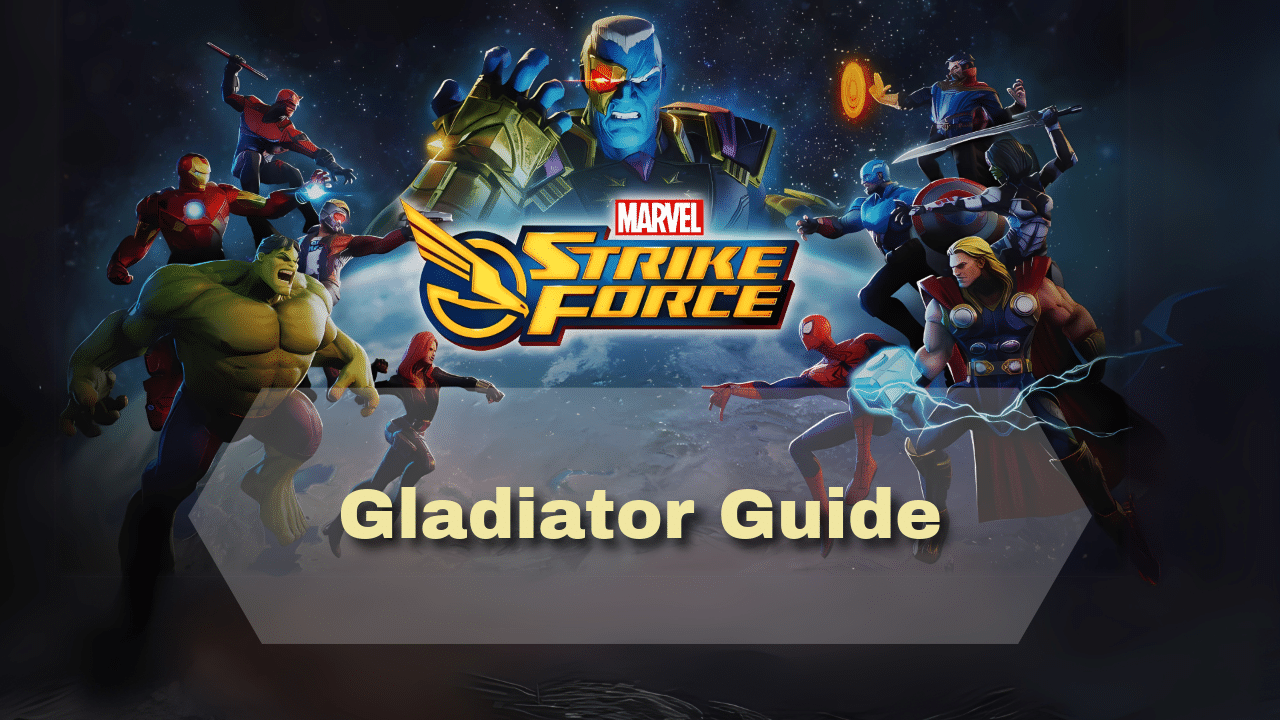
Introduction
Gladiator has made his debut in Marvel Strike Force as a dynamic new addition to the game, introducing the Annihilator team. As the first member of this powerful team, Gladiator stands out as a pre-taunt Protector, immediately influencing the Arena meta. For players looking to maximize his potential, the Marvel Strike Force Gladiator Guide provides essential tips on his abilities, synergy with other Annihilator characters, and effective strategies for positioning him in your roster. With Gladiator leading the charge, understanding how to leverage his unique abilities will be key to dominating your opponents in both offense and defense.
His role is crucial, as he excels at soaking up damage and safeguarding his allies. Gladiator’s abilities are intricately tied to his health and confidence, making him a formidable force on the battlefield. His tanking capabilities ensure that he can absorb hits while enabling his teammates to deal damage without fear of being overwhelmed. Gladiator’s introduction offers a new strategy for players, as his kit provides substantial utility both in the Arena and in other game modes.
Additionally, his accessibility through a free event makes him an attractive character to build for any player looking to enhance their roster. Whether you’re just starting out or advancing in the game, Gladiator’s potential as a cornerstone character cannot be understated.
Gladiator’s Abilities
Gladiator’s abilities in Marvel Strike Force are centered around a unique mechanic that changes depending on whether his health is above or below 50% of his maximum. This reflects his lore, where his powers grow with his confidence and self-belief. Here’s a breakdown of his abilities:
Meteoric Slam
Level: 1
Damage: 50
Minus Level Level Up!Tectonic Lift
Level: 1
Damage: 100
Minus Level Level Up!Shi’ar Showdown
Level: 1
Damage: 100
Minus Level Level Up!Shiars Rage
Level: 1
Heal Self: 5
Minus Level Level Up!Basic – Meteoric Slam: Gladiator strikes the primary target and adjacent enemies, dealing damage. If his health is above 50%, he applies Offense Down for two turns to each target. If his health is below 50%, the attack gains 25% Drain, healing Gladiator for a portion of the damage dealt.
Special – Tectonic Lift: This powerful move has a five-turn cooldown and serves as an opening strike. Gladiator clears Barrier from all enemies, then flips all negative effects on himself and Annihilator allies into positive effects before attacking all enemies. If his health is above 50%, he also clears all positive effects from enemies. If his health is below 50%, he applies Immunity and Regeneration to himself and all Annihilator allies for two turns. This attack is unavoidable, unblockable, and cannot be counterattacked. Gladiator also grants Safeguard to himself and all Annihilator allies for two turns.
Ultimate – Shi’ar Showdown: This ultimate ability has a 5/5 energy cost and can either damage enemies or provide healing and protection. If Gladiator’s health is below 50%, he gains Barrier, heals himself for 50% of his max health, and heals all Annihilator allies for 40%. He also generates three Ultimate Ability Energy for himself and attacks the primary target with a 30% increased critical hit chance. If his health is above 50%, he reduces the speed bar of the primary target by 50% and gains Taunt and Immunity for two turns.
Passive – Shi’ar’s Rage: Gladiator’s passive provides a powerful start in battle. On spawn, he gains Taunt, Defense Up, Safeguard, and Immunity for himself and all Annihilator allies. If his health drops below 50%, he heals for 5% of his max health each turn. If his health falls below 30%, he gains 2 Regeneration, loses his Taunt (gaining Stealth instead), and Stealth overrides Taunt and bypasses Safeguard.
If Gladiator has two or more Annihilator allies and his health is above 50%, he and his allies cannot gain Exposed or Vulnerable, which is especially useful against enemies that rely on those debuffs. In Arena, Annihilator allies cannot gain Slow, and while Gladiator’s health is above 50%, enemies cannot fill or reduce their speed bar, preventing bonus speed bar gains and reductions, though normal speed bar gains still apply.
These abilities make Gladiator a formidable protector, with the ability to shift the tide of battle by either absorbing damage, healing his team, or disrupting enemy strategies based on his health thresholds.
T4 Ability Priorities
When deciding on T4 upgrades for Gladiator, it’s important to focus on abilities that enhance his effectiveness in the Arena and across other game modes. Here’s a recommended order of priorities:
The Passive – Shi’ar’s Rage should be the highest priority for T4 upgrades. This upgrade is considered essential as it grants Gladiator and all Annihilator allies Immunity and Safeguard on spawn, which, combined with his Taunt and Defense Up, makes him extremely difficult to take down early in a match. It also extends the duration of the Defense Up buff to two turns for himself and all Annihilator allies, significantly improving his team’s survivability. This T4 upgrade is valuable in all game modes, making it a top investment.
The Special – Tectonic Lift comes next and is also a high priority. The T4 upgrade for this ability is nearly essential. It allows Gladiator to clear all Barrier from enemies, which can be crucial against teams that rely on this buff. It also boosts the damage of the attack by 60% and enhances the ability to clear buffs by removing all positive effects from all enemies instead of just two. Additionally, it increases the Regeneration applied to allies to three Regenerations for two turns, greatly improving team sustain.
The Ultimate – Shi’ar Showdown T4 upgrade is also important. If Gladiator’s health is below 50%, this upgrade makes him generate three Ultimate Ability Energy for himself, enabling him to use his Ultimate more frequently. If his health is above 50%, it adds the ability to reduce the speed bar of the primary target by 50%, disrupting enemy speed mechanics. The upgrade also increases the damage by 70%, making the Ultimate more impactful.
The Basic – Meteoric Slam T4 upgrade is considered the lowest priority. It only increases the damage of the attack, which isn’t as valuable as the utility and survivability provided by Gladiator’s other abilities. Since Gladiator is primarily a tank and not a damage dealer, this upgrade should be skipped unless you’re a completionist.
In summary, prioritize T4 upgrades for Gladiator’s Passive, Special, and Ultimate abilities to maximize his effectiveness on your team. The T4 for his Basic attack can be ignored for most players.
ISO-8 Class Recommendations
Gladiator’s role as a protector, with his unique mechanics tied to his health, makes choosing the right ISO-8 class crucial for maximizing his effectiveness. The Fortifier class is widely considered the best starting option for Gladiator, as it enhances his survivability by providing additional barrier. This extra barrier helps Gladiator stay above 50% health, which is key for triggering his passive abilities, including preventing enemies from manipulating the speed bar in the Arena. The extra survivability from Fortifier is vital for keeping Gladiator effective as a pre-taunt tank. However, some players note that in mirror matches, where Gladiator’s team may already clear a lot of barriers, the extra barrier may be less impactful.
For those looking to improve the overall sustainability of their team, the Healer class can be a good alternative. This option boosts the healing from Gladiator’s abilities, making it an effective choice if you want to maximize the regeneration and healing aspects of his kit. This can help keep both Gladiator and his allies alive longer during extended battles.
The Skirmisher class can be considered if you want Gladiator to be more offensive, especially when dealing with enemies that benefit from Vulnerable. This option could be beneficial if Gladiator has higher star levels or if you want to use his basic attack more frequently. Skirmisher may help increase Gladiator’s ability to apply more debuffs to enemies, adding utility for those seeking an offensive edge.
The Striker class is another offensive choice, though less recommended compared to Skirmisher. Gladiator’s primary role isn’t as a damage dealer, and his abilities are focused on providing protection and support to his team. However, in cases where Gladiator has a higher star level or larger stats, some players may find Striker useful for adding more damage to his attacks, particularly when combined with his strong debuffing abilities.
While Fortifier is the most common recommendation, the best ISO-8 class ultimately depends on your specific team composition, strategy, and the challenges you face. Remember, you can always switch to a different class for 100,000 blue ISO-5 ions, allowing for flexibility. Starting with Fortifier to maximize Gladiator’s survivability and team support is typically the best approach, but players may choose to experiment with other classes as they build Gladiator’s stats and tailor him to their preferred playstyle.
Synergies and Team Compositions
Gladiator’s primary synergy is with the Annihilator team, but his unique abilities and passives make him a versatile character who can be used effectively in other team compositions, especially in the Arena.
The core Annihilator team consists of Gladiator, Gore, and Thanos (Endgame). Gladiator serves as the protector and tank, using his on-spawn taunt, safeguard, immunity, and defense up to provide strong protection for his team. His passive ability prevents enemies from manipulating the speed bar when his health is above 50%, making him a crucial asset in the Arena.
Gore counters assist attacks and prevents bleed on Annihilator allies, which is particularly useful against characters like Old Man Logan. Thanos (Endgame) provides significant control, negating immunity and trauma on the Annihilator team, while generating ability energy for himself and allies when enemies with exposed are attacked.
Thanos is widely considered the most dominant and important member of the team. Although Ultimus and Silver Surfer are also part of the Annihilator faction, they are less viable in the Arena compared to the core three members. Ultimus offers utility with his chance to ability block and rewind turn meter, while Silver Surfer can manipulate speed but is not a central character for the team.
While Gladiator is best used with the Annihilator team, his abilities allow him to fit well into other team compositions, especially in the Arena. For example, Gladiator can replace Ms. Marvel (Hard Light), as his passives and on-spawn taunt provide more utility and survivability. Gladiator can also replace Black Knight on certain teams, but having both Gladiator and Black Knight on the same team may cause their taunts to overlap. Gladiator’s ability to prevent speed bar manipulation makes him an excellent addition to any Arena team, particularly when facing teams that rely on speed. His passive ability can disrupt the turn order of enemy teams, slowing down opponents like Super Skrull or Apocalypse who depend on speed manipulation.
If you don’t have access to all the core Annihilators, you can still create a strong Arena team by pairing Gladiator with characters like Old Man Logan, Apocalypse, Super Skrull, or Black Knight. You might also consider Nick Fury for his speed-up ability, although this effect is limited to one turn. Gladiator’s on-spawn abilities, including his taunt and defense buffs, make him a valuable tank and protector, regardless of the team composition.
His health management is critical, as maintaining his health above 50% is essential for maximizing his passive abilities, including the prevention of speed bar manipulation and reducing exposure or vulnerability on his team. Gladiator’s ability to counter speed-based teams, exposed or trauma heavy teams, and speed bar manipulation makes him an excellent plug-and-play character in the Arena.
In summary, Gladiator’s primary synergy lies with the Annihilator team, where his protection and control abilities shine. However, his unique kit and passive abilities make him a valuable addition to virtually any Arena team, particularly against those that rely on speed or speed bar manipulation. He excels as a tank and protector, and his effectiveness only increases when paired with other Annihilator members.
How to Obtain Gladiator
Obtaining Gladiator involves a combination of methods, including orbs, events, and milestones. Players could acquire Gladiator shards through different sources, each playing a role in his availability.
Gladiator Orbs were one of the main ways to unlock him. Specifically, players could purchase Shar’s Finest Orb, Annihilator Orbs, and Arena Orbs. These orbs contained Gladiator shards, with the Shar’s Finest Orb and Annihilator Orbs being more targeted for acquiring him, while Arena Orbs provided Gladiator shards as a secondary, less consistent source over time. These Arena Orbs were also part of milestone events, which granted additional points for opening them.
Events were a central method for obtaining Gladiator shards. A notable event, Gladiator’s “Greater Purpose” Event, provided players with an opportunity to earn 100 Gladiator shards. This event required players to spend ISO-8 campaign energy, participate in Cosmic Crucible battles, and blitz with Annihilator characters to earn points. A web milestone component of the event required spending radioactive treats to purchase ISO purple crystals, adding another layer of participation. In addition, Gladiator shards could also be obtained through other events that featured the Annihilator team, which rewarded Annihilator orb fragments as well.
Milestones played a significant role in obtaining Gladiator, with the Gladiator Expedition Milestone awarding both Annihilator orb fragments and Gladiator shards. This milestone was a key part of obtaining Gladiator, especially for players who participated in the event. Additionally, the “Greater Purpose” event also had a web milestone component where players could earn points by spending radioactive treats.
To maximize progress, hoarding power cores was a useful strategy for players who wished to accelerate Gladiator’s acquisition through orb purchases. Consistent Arena participation was also important, as it provided Gladiator shards over time, although the drop rate was lower. Actively engaging in events, particularly the “Greater Purpose” event, and effectively managing resources like ISO-8 energy and radioactive treats were essential for unlocking Gladiator more quickly.
Gladiator was the first core Annihilator character to be released, followed by Gore and Thanos (Endgame). The “Greater Purpose” event was specifically designed to compensate for delays in Gladiator’s release and was adjusted based on community feedback to make it easier for players to complete.
In summary, obtaining Gladiator involved participating in events, purchasing orbs, and completing milestones. Players who engaged actively in these methods could effectively unlock and build Gladiator. Resource management, such as saving power cores and participating in key events, played a critical role in speeding up the process.
Gladiator in Arena
Gladiator plays a pivotal role in the Arena, primarily as a pre-taunt protector and a supportive tank. His design revolves around controlling the flow of battle by drawing enemy attacks with his taunt and providing key buffs to his team. One of his most impactful abilities is his ability to disrupt the speed meta, which focuses on manipulating turn meters to gain an advantage. Gladiator’s presence in the Arena forces teams that rely on speed manipulation, like those with Apocalypse and Super Skrull, to rethink their strategies.
Gladiator’s on-spawn effects make him a strong presence from the very start of the match. Upon spawning, he provides taunt, defense up, immunity, and safeguard to himself and all Annihilator allies. His speed bar manipulation becomes a critical asset when he is above 50% health, as it prevents enemy teams from filling or reducing their speed bar through any means other than normal turn meter gain.
This is crucial for shutting down teams that rely on turn meter manipulation to gain an advantage. Additionally, Gladiator and his Annihilator allies cannot gain slow in the Arena, and Gladiator himself, along with his allies, is immune to exposed and vulnerable when Gladiator’s health is above 50% and there are two or more Annihilator allies on the team.
Gladiator’s abilities are also closely tied to his health. Above 50% health, his basic attack applies Offense Down, his special clears all positive effects from enemies, and his ultimate reduces the primary target’s speed bar by 50% while granting taunt and immunity. Below 50% health, his basic attack gains drain, his special applies immunity and regeneration to himself and his allies, and his ultimate grants barrier and ultimate ability energy. His special ability clears barriers from enemies and flips negative effects to positive for allies, while his ultimate ability varies based on his health, either reducing the enemy’s speed bar or providing barrier and energy to the team.
One of Gladiator’s most important contributions in the Arena is his passive ability, which provides additional taunt, defense up, immunity, safeguard, and healing under certain conditions. These abilities make Gladiator an effective counter to existing meta teams, particularly those that rely on speed manipulation and turn meter control. Gladiator forces players to rethink their team compositions, as his presence can disrupt many of the current meta strategies.
The key to maximizing Gladiator’s effectiveness is health management. Keeping Gladiator above 50% health is essential for unlocking his full potential and preventing enemies from manipulating turn meter. This also makes upgrades like red stars, yellow stars, and the Fortifier ISO-8 class vital for Gladiator’s success. In mirror matches, the player who can get Gladiator below 50% health first gains an advantage, as this is when speed manipulation and other effects can be used.
Gladiator’s passive abilities also make him incredibly effective on defense in Arena, as he disrupts the turn order of common offensive teams. Although he is a core member of the Annihilator team, Gladiator is versatile and can be used outside of this team as a pre-taunt protector, making him a valuable asset to many team compositions.
In terms of synergies, Gladiator excels when paired with other Annihilator characters, as they enhance each other’s effectiveness. While characters like Ultimus and Silver Surfer are part of the Annihilator team, they are not always the best fit for maximizing Gladiator’s potential. The Fortifier ISO-8 class is recommended for Gladiator to help maintain his health and provide additional barrier, but other ISO-8 classes such as Healer, Raider, or Skirmisher may also be viable depending on the team composition and how Gladiator is built. T4 upgrades for his passive, special, and ultimate abilities are essential, with his basic T4 being optional.
In summary, Gladiator is a formidable force in the Arena due to his ability to disrupt speed-based strategies, his health-based mechanics, and his strong synergies with the Annihilator team. His impact on the Arena meta is undeniable, and his versatile role as a pre-taunt protector and tank makes him a valuable addition to many teams.
Gladiator in Other Game Modes
Gladiator, while primarily designed for Arena, proves to be a valuable asset in several other game modes due to his tanking, support, and disruptive capabilities. His on-spawn effects, such as providing taunt, defense up, immunity, and safeguard, make him a powerful protector right from the start of any battle. These buffs not only bolster his own defenses but also benefit all Annihilator allies.
His Exposed/Vulnerable Immunity, which prevents Gladiator and his Annihilator allies from gaining exposed or vulnerable when he has two or more Annihilator teammates and is above 50% health, makes him especially effective in modes like Dark Dimension, where enemies often rely on striker attacks that can eliminate characters quickly. Additionally, Gladiator’s healing and regeneration abilities further enhance his survivability across game modes. When below 50% health, he heals himself for 5% of his max health each turn, and if his health falls below 30%, he gains regeneration, which significantly extends his longevity in battles.
Gladiator’s health-based abilities change depending on whether he is above or below 50% health. When above 50%, his basic attack applies Offense Down to enemies, his special clears all positive effects from enemies, and his ultimate reduces the speed bar of the primary target. When below 50%, his basic attack gains drain, his special provides immunity and regeneration to himself and his Annihilator allies, and his ultimate grants barrier and energy. These dynamic abilities give Gladiator both offensive and defensive versatility, making him adaptable to various situations across game modes.
In Cosmic Crucible, Gladiator’s ability to provide safeguard and immunity to himself and his allies right from the start of the match, along with preventing exposed and vulnerable, makes him a valuable defender. Although his speed manipulation is less effective in Cosmic Crucible compared to Arena, he still offers significant disruption.
In Dark Dimension, Gladiator’s tanking ability, along with his immunity to exposed and vulnerable, helps him withstand the heavy damage output from enemies, which often utilize striker attacks. Gladiator’s sustainability is also beneficial in Raids, where he can act as a reliable protector, keeping his team alive while providing support. In Blitz and Real-Time Arena, Gladiator excels thanks to his strong on-spawn abilities, high survivability, and his ability to disrupt enemy strategies. In Alliance War, Gladiator’s role as a tank and support character makes him a solid choice for both offense and defense, especially when used in synergy with his Annihilator teammates.
Although Gladiator is most effective when paired with his Annihilator team, he is a versatile plug-and-play character who can be included in many different team compositions due to his strong basic kit. For his ISO-8 class, Fortifier is commonly recommended for his ability to maintain his health and provide additional barrier, though Healer can be a good option outside of Arena to further enhance his support role. Raider is also a viable option, depending on the team’s needs. The key T4 upgrades for Gladiator, regardless of the game mode, are his passive, special, and ultimate abilities, which greatly enhance his overall performance.
However, Gladiator does have some limitations. He is somewhat tied to the Annihilator team, which means his effectiveness can be reduced outside of this synergy. His speed bar manipulation abilities, for example, are mainly useful in Arena and don’t have as much impact in other game modes. Additionally, managing his health mechanics can be tricky, as his abilities are optimized depending on whether he is above or below 50% health, and this cannot always be easily controlled. Lastly, while Gladiator performs well in most content, he is not considered a top performer in Dark Dimension 7.
In conclusion, Gladiator’s versatile kit makes him a useful character in various game modes, from Cosmic Crucible to Raids and Blitz, thanks to his tanking, support, and disruptive abilities. While his greatest strengths are seen in Arena, his defensive capabilities, healing, and debuff prevention make him an asset in a variety of settings. Players should consider his synergies with the Annihilator team and tailor his ISO-8 class and T4 upgrades to suit the specific needs of each game mode.
Conclusion
Gladiator is a powerful and versatile character in Marvel Strike Force, designed primarily for the Arena but also highly effective in other game modes. As a pre-taunt protector, his kit provides significant disruption, support, and survivability. His unique mechanics, especially those tied to his health and team composition, contribute to his overall strength.
In Arena, Gladiator is a meta-defining character, largely due to his ability to disrupt speed manipulation and control turn meter for enemies. He prevents enemies from filling or reducing their speed bar when above 50% health, which counters many common Arena strategies. His immunity to slow and ability to prevent his team from gaining exposed or vulnerable further cements his place as a top-tier Arena character. Gladiator’s versatility extends beyond Arena, making him useful in Dark Dimension, Raids, and Cosmic Crucible.
His on-spawn taunt, defense up, immunity, and safeguard provide valuable protection and defense in any game mode. Additionally, his healing and regeneration abilities ensure sustainability in modes like Dark Dimension, where survivability is key. His ability to prevent exposed and vulnerable is especially beneficial in Cosmic Crucible and Dark Dimension, where such debuffs can have a significant impact.
Gladiator is a core member of the Annihilator team, and his full potential shines when paired with other Annihilator characters. However, he is also a strong plug-and-play character thanks to his robust base kit. His health-based abilities add strategic depth to his gameplay. When above 50% health, he can disrupt speed bars, while being below 50% health provides important support to his team.
Gladiator’s basic attack will gain drain, his special will grant immunity and regeneration, and his ultimate can either reduce an enemy’s speed bar or provide him with barrier and ability energy, depending on his health. His strong kit includes abilities that clear barrier from enemies, flip negative effects to positive on allies, provide safeguard to allies, and grant healing with his ultimate.
When it comes to ISO-8, the Fortifier class is typically recommended, especially to start. For modes outside of Arena, Healer or Raider classes may also be viable, depending on the team’s needs. Gladiator’s most important T4 upgrades are for his passive, special, and ultimate abilities, while his basic ability T4 is skippable. While Gladiator is part of the Annihilator team, not all original members of the team (such as Ultimus and Silver Surfer) are the ideal choice alongside him. Newer team members like Apocalypse are better fits to maximize Gladiator’s potential.
Health management is critical for Gladiator, as many of his abilities and passives depend on whether he is above or below 50% health. In mirror matches, it’s essential to focus on getting Gladiator below 50% health to enable speed bar manipulation. Gladiator is most effective in Arena, where his abilities are tailored to that game mode. His effectiveness in Dark Dimension 7 is limited, as his strengths are not as impactful in that context.
Overall, Gladiator is a top-tier character that is invaluable to players, especially in Arena. His disruptive abilities, health-based mechanics, and synergy with the Annihilator team make him a force to be reckoned with. Players should focus on building him up, prioritizing his key T4 upgrades, and choosing the right ISO-8 class to suit their goals.













